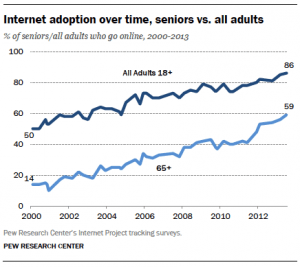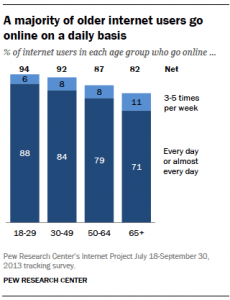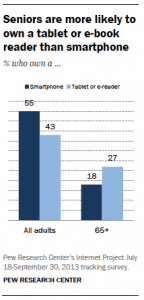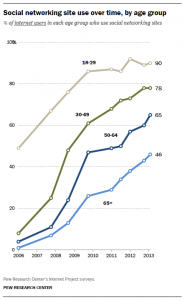Although technology isn’t as popular with the older generations it is growing rapidly in the past few years. The graphs below highlight that seniors of 50+ are more familiar with technology than what they were a few years and this only suggests that this will only increase in the future years. As generations are using technology and the internet both at work and in their daily lives the population is adapting a techno-society where it will become common knowledge in the future.
The graph below shows the internet usage in 18+ and 65+ ages from 2000 to 2013. The 18+ age has grown from 50% usage to 86% showing a 36% rise in 13 years. Compare this to the 65+ age group the difference is 45% increase. This highlights that more seniors are using technology to access the internet at a more rapid rate than younger generations. This could be because there are now numerous classes available to adapt elders with technology and keep them in contact easier with family and friends.
http://www.pewinternet.org/2014/04/03/usage-and-adoption/
Age UK write: ‘There is clear evidence that the use of modern technologies, particularly the internet, as a method for establishing and maintaining social contact is on the increase among the older population. Although exclusion from technology increases with age, the pattern both of access and use is changing appreciably year by year, especially now that those retiring are more likely to have used information and contact technology as part of their jobs.’
The graph below shows how often internet users access the internet on a daily basis. The graph shows that seniors that do access the internet over technology do access it almost as much as the younger generations. This suggests that if more elderly people were taught how to use technologies and were assisted in their access the market for elderly people on the internet would be increased further.
I wanted to aim my product for use on tablets as the use of larger screens will make it easier for the user to read and navigate with large buttons and text to be easily legible. The graph below shows that tablets are 9% more popular than smartphones in the 65+ age group in 2013, since there is still a market within smartphones I could also make the app accessible on smartphones also.
For some further up to date statistics the Office For National Statistics found that:
‘In 2011, the percentage of recent internet users aged 75 and over was 19.9%. In 2016, this has nearly doubled to 38.7%, up from 33.0% in 2015.’
‘Recent internet use in the 65 to 74 age group has increased by 68.7% since 2011. Since 2015, there has been an increase of 7.5% in the same age group.’
Relating to social media, although the older age groups are the lowest users the graph still shows a rapid increase in the past few years in 65+ age groups using social networking. Social networking is a useful media for elderly people to stay in touch with friends and family and stay connected and sociable. With the result of this increase I think my app can come into use with a social network tailored for the older generation.
Age UK write: ‘email and social networking sites are becoming as useful a means of keeping in touch with family and friends as the telephone’. I base my need for my app on the basis that older generations are increasingly using the internet and for the purpose of staying in contact and therefore reducing loneliness and isolation.
According to a report by Pew Research Centre 35% of all adults aged 65 and older said they’re on social media. That’s more than triple what was reported in 2010, when only 11% said they were social media users. I think there is a gap in the market for a social media platform tailored towards the elderly as this percentage will only continue to grow as we have seen in the past few years.



